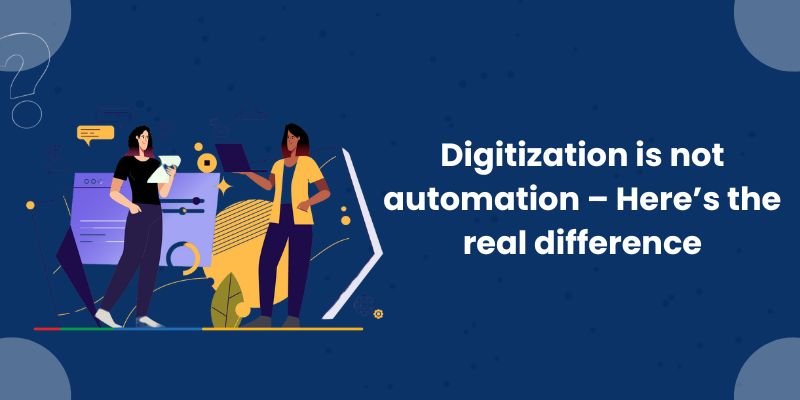In the last decade, schools across the country have taken enormous strides toward modernization. Paper forms have moved online. Notices are emailed instead of printed. Attendance is typed into Excel instead of written into registers. For many institutions, this marks the shift toward becoming a “digital school.”
But here’s a reality check: digitization is not automation. And for school administrators who are serious about efficiency, growth, and future-readiness, understanding this distinction is critical.
What Is Digitization?
Digitization refers to the process of converting information or workflows from analog (paper/manual) format into a digital one. It is the first, necessary step in modernizing school operations.
For example:
- Converting a paper admission form into an online form.
- Replacing a physical notice board with a PDF circulated over email.
- Recording attendance in a Google Sheet instead of a diary.
Digitization simplifies access to information. It makes processes cleaner, faster, and more easily archived. But — and this is key — it doesn’t reduce the workload. Your staff are still entering data, compiling reports, and repeating tasks every day. They’re just doing it on a screen instead of on paper.
This is where many schools stall. They stop at digitization and assume they’ve transformed. In reality, they’ve only modernized the surface.
What Is Automation?
Automation goes a step further. It doesn’t just present data digitally — it performs actions, makes decisions, and triggers workflows without manual intervention.
With automation:
- A parent fills out an online admission form → the system sends an acknowledgment, allocates a registration number, and schedules an interview slot automatically.
- A teacher marks attendance → parents of absentees are auto-notified via SMS or app.
- A student pays fees online → the ERP sends a receipt, updates the ledger, and reflects it in financial reports in real time.
Automation removes repetition. It eliminates the need for follow-ups. It ensures consistency and saves time — every single day.
Why the Difference Matters
If you’re running a school, you’re running a complex, multi-stakeholder ecosystem. Teachers, parents, students, accountants, front office staff — all have different needs and responsibilities.
Now imagine trying to manage that system with tools that only digitize, but don’t automate.
- You still have to remind teachers to upload marks manually.
- Your admin still has to follow up with transport vendors for route changes.
- Your finance team still spends hours reconciling fee payments every month.
These are tasks that could — and should — be automated.
Why?
Because your time, and your team’s time, is better spent on planning, strategizing, and improving learning outcomes — not clicking through spreadsheets and chasing updates.
Here’s a quick comparison:
| Task | Digitized | Automated |
| Fee Payment | Online payment via portal | Auto-generated receipt, ledger update, and real-time report |
| Attendance | Entered in Excel | Biometric/RFID-based, real-time alerts to parents, automatic report |
| Admissions | Online forms collected manually | Lead-to-admission workflow with status updates, follow-ups, and schedule triggers |
| Timetable | Made using Excel | AI-generated timetables considering subject loads, availability, and substitutions |
| Announcements | Typed into email groups | Scheduled or instant push notifications across all channels from one dashboard |
The Hidden Cost of Stopping at Digitization
Let’s say your staff spends an average of 3 hours a day on routine admin tasks: updating registers, sending reminders, manually processing records, compiling reports.
That’s 60 hours a month. Multiply that by 10 staff members — and you’re losing 600 man-hours a month to work that could easily be automated.
Now ask yourself: what could your school do with that time saved?
- Better parent engagement
- Timely performance interventions
- Staff development programs
- Strategic planning
Automation isn’t about replacing people. It’s about giving people their time back — so they can focus on what truly matters.
Common Myths
1. “Our school is small. We don’t need automation.”
Automation doesn’t depend on size. In fact, smaller schools benefit the most because they have limited staff and tighter resources. An automated ERP levels the playing field.
2. “We already have software.”
Most basic ERPs digitize — they don’t automate. If your system still needs staff to manually transfer data between modules, it’s not a true automation platform.
3. “It will be too expensive.”
Automation saves money in the long run by reducing errors, improving efficiency, and lowering dependency on multiple disconnected tools or outsourced work.
What True School Automation Looks Like
At VAPS, we’ve worked with hundreds of schools across India — from single-branch institutions to large international chains. And the one thing we’ve learned is this: automation is not a luxury — it’s a necessity for sustainable growth.
Our Vaps ERP system is built with automation at its core. Here’s what it offers:
- Fully integrated modules: Admissions, academics, fees, transport, inventory, and communication — all talking to each other.
- Role-based dashboards: Personalized views for principals, admin staff, teachers, students, and parents.
- One-click communication: SMS, email, app push notifications — all managed from one place.
- Auto-generated reports: Attendance summaries, fee defaulters, academic trends — instantly available, no manual compilation.
- AI-powered suggestions: Identify at-risk students, optimize timetables, and spot behavioral trends before they escalate.
Every feature is designed to lighten the administrative load and empower decision-making.
In today’s competitive educational landscape, a school’s success depends on two things:
- Its ability to provide quality education
- Its ability to manage operations efficiently
Digitization helps you look modern. Automation helps you act modern.
If your school is still stuck in manual processes — even if they’re done on computers — it’s time to evolve. The real transformation happens when your system works with you, not just for you.
The future of education belongs to schools that don’t just adopt technology — but leverage it intelligently.












